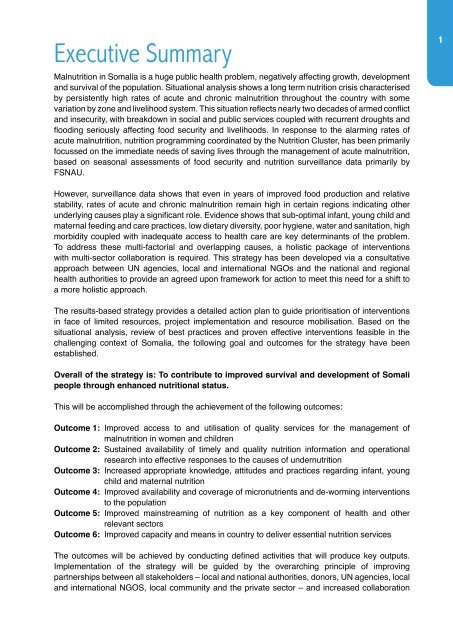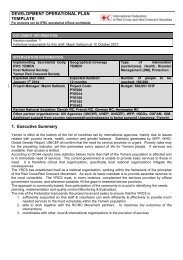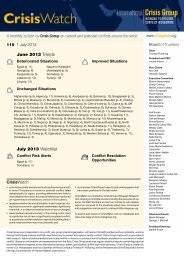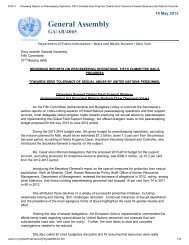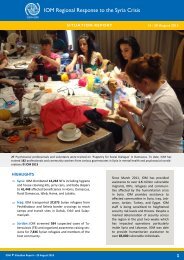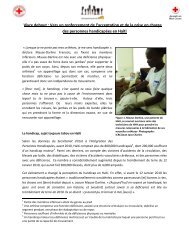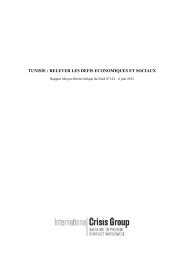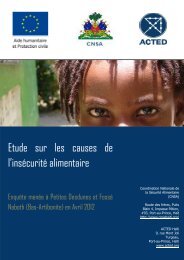SOMALI NUTRITION STRATEGY 2011 – 2013 - ReliefWeb
SOMALI NUTRITION STRATEGY 2011 – 2013 - ReliefWeb
SOMALI NUTRITION STRATEGY 2011 – 2013 - ReliefWeb
You also want an ePaper? Increase the reach of your titles
YUMPU automatically turns print PDFs into web optimized ePapers that Google loves.
Executive Summary<br />
Malnutrition in Somalia is a huge public health problem, negatively affecting growth, development<br />
and survival of the population. Situational analysis shows a long term nutrition crisis characterised<br />
by persistently high rates of acute and chronic malnutrition throughout the country with some<br />
variation by zone and livelihood system. This situation reflects nearly two decades of armed conflict<br />
and insecurity, with breakdown in social and public services coupled with recurrent droughts and<br />
flooding seriously affecting food security and livelihoods. In response to the alarming rates of<br />
acute malnutrition, nutrition programming coordinated by the Nutrition Cluster, has been primarily<br />
focussed on the immediate needs of saving lives through the management of acute malnutrition,<br />
based on seasonal assessments of food security and nutrition surveillance data primarily by<br />
FSNAU.<br />
1<br />
However, surveillance data shows that even in years of improved food production and relative<br />
stability, rates of acute and chronic malnutrition remain high in certain regions indicating other<br />
underlying causes play a significant role. Evidence shows that sub-optimal infant, young child and<br />
maternal feeding and care practices, low dietary diversity, poor hygiene, water and sanitation, high<br />
morbidity coupled with inadequate access to health care are key determinants of the problem.<br />
To address these multi-factorial and overlapping causes, a holistic package of interventions<br />
with multi-sector collaboration is required. This strategy has been developed via a consultative<br />
approach between UN agencies, local and international NGOs and the national and regional<br />
health authorities to provide an agreed upon framework for action to meet this need for a shift to<br />
a more holistic approach.<br />
The results-based strategy provides a detailed action plan to guide prioritisation of interventions<br />
in face of limited resources, project implementation and resource mobilisation. Based on the<br />
situational analysis, review of best practices and proven effective interventions feasible in the<br />
challenging context of Somalia, the following goal and outcomes for the strategy have been<br />
established.<br />
Overall of the strategy is: To contribute to improved survival and development of Somali<br />
people through enhanced nutritional status.<br />
This will be accomplished through the achievement of the following outcomes:<br />
Outcome 1: Improved access to and utilisation of quality services for the management of<br />
malnutrition in women and children<br />
Outcome 2: Sustained availability of timely and quality nutrition information and operational<br />
research into effective responses to the causes of undernutrition<br />
Outcome 3: Increased appropriate knowledge, attitudes and practices regarding infant, young<br />
child and maternal nutrition<br />
Outcome 4: Improved availability and coverage of micronutrients and de-worming interventions<br />
to the population<br />
Outcome 5: Improved mainstreaming of nutrition as a key component of health and other<br />
relevant sectors<br />
Outcome 6: Improved capacity and means in country to deliver essential nutrition services<br />
The outcomes will be achieved by conducting defined activities that will produce key outputs.<br />
Implementation of the strategy will be guided by the overarching principle of improving<br />
partnerships between all stakeholders <strong>–</strong> local and national authorities, donors, UN agencies, local<br />
and international NGOS, local community and the private sector <strong>–</strong> and increased collaboration


